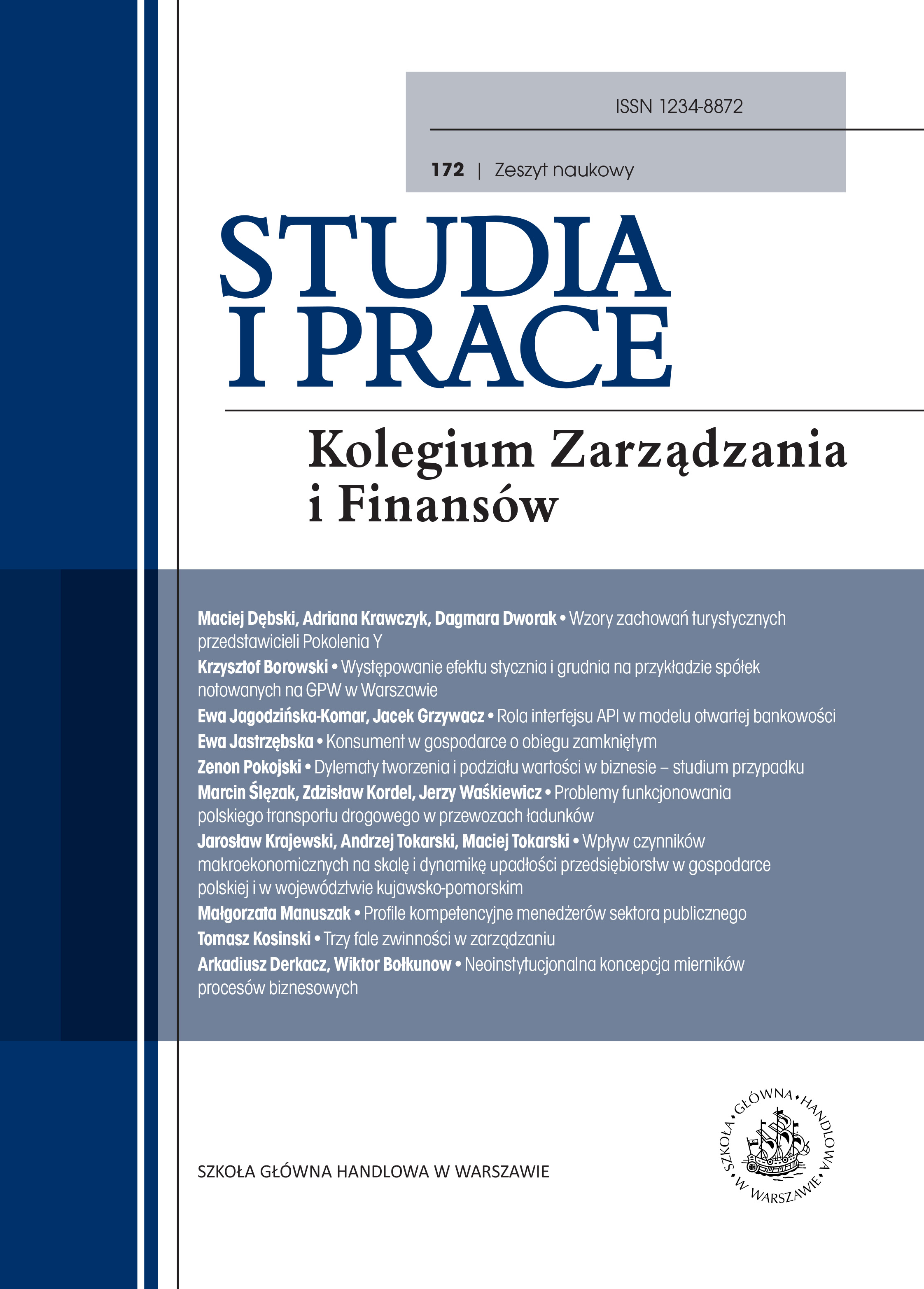Neo-institutional Concept of Business Process Measures
DOI:
https://doi.org/10.33119/SIP.2019.172.10Keywords:
enterprise, efficiency of economic processes, business processesAbstract
Authors have made an attempt to examine the possibilities of finding an optimal operational path in a company. The main goal is to discuss an original idea of neo-institutional business process measures, which provide the foundations for effective management of business processes within an enterprise. The above delineated path intended to improve the efficiency of economic processes is seen through the lenses of a wide array of determinants, mainly neo-institutional determinants of business processes. Considerations have led the authors to the conclusion that neo-institutional determinants of business processes are vital for the efficiency of operating activities of enterprises.
Downloads
References
2. Bień J., Worwąg M., Grosser A., Nowak D., Milczarek M., Janik M. [2011], Kierunki zagospodarowania osadów w Polsce po roku 2013, „Inżynieria i Ochrona Środowiska”, t. 14, nr 4, s. 375–384.
3. Brousseau E., Glachant J. M. [2008], New Institutional Economics, Cambridge University Press, Cambridge.
4. Bukłaha E. [2016], Controlling projektów w organizacjach działających w Polsce – wyniki badań, „Studia i Prace Kolegium Zarządzania i Finansów Szkoła Główna Handlowa”, nr 136, s. 143–158.
5. Chyłek E., Rzepecka M. [2011], Biogospodarka – konkurencyjność i zrównoważone wykorzystanie zasobów, „Polish Journal of Agronomy”, nr 7, s. 3–13.
6. Coase R. [1937], The Nature of the Firm, „Economica”, t. 4, nr 16, s. 386–405.
7. Derkacz A. [2018], W poszukiwaniu efektywności inwestycji publicznych, My Book, Szczecin.
8. Garrouste P., Saussier S. [2008], The Theories of the Firm, w: New Institutional Economics. A Guidebook, red. E. Brousseau, J. M. Glachant, Cambridge University Press, Cambridge.
9. Golec T. [2004], Współspalanie biomasy w kotłach energetycznych, „Energetyka”, nr 7–8, s. 437–445.
10. Hodgson G. M. [2006], What Are Institutions?, „Journal of Economic Issues”, t. XL, nr 1, s. 1–25.
11. Kirdina S., Sandstrom G. [2010], Institutional Matrices Theory as a Framework for both Western and Non-Western People to Understand the Global Village, „Non-Western Challenges to Western Social Theory”, zaprezentowano na World Congress of Sociology International Sociological Association International Sociological Association, Gothenburg (Sweden).
12. Kurapati V., Petri-Net A. [1995], Based Methodology for Modeling, Simulation and Control of Flexible Manufacturing Systems, New Jersey Technology University, New Jersey.
13. McCaffrey T. [2011], Innovation Relies on the Obscure: A Key to Overcoming the Classic Problem of Functional Fixedness, „Psychological Science”, t. 23, nr 3, s. 215–218.
14. Peterson J. L. [1981], Petri Net Theory and the Modeling of Systems, Prentice Hall, Englewood Cliffs.
15. Romanowska M. [2009], Planowanie strategiczne w przedsiębiorstwie, PWE, Warszawa.
16. Stabryła A. [2010], Analiza i projektowanie systemów zarządzania przedsiębiorstwem, Mfiles.pl, Kraków.
17. Strzelczyk F., Wawszczak A. [2008], Efektywność biomasy jako paliwa energetycznego, „Rynek Energii”, nr 5, s. 51–57.
18. Trocki M. [2012], Kompleksowa ocena projektów, „Studia i Prace Kolegium Zarządzania i Finansów Szkoła Główna Handlowa”, nr 113, s. 7–23.
19. Vanni F. [2014], Agriculture and Public Goods, Springer Science, Dordrecht.
20. Williamson O. E. [1981], The Modern Corporation: Origins, Evolution, Attributes, „Journal of Economic Literature”, nr 19 (4).
21. Williamson O. E. [2002], The Theory of the Firm as Governance Structure: From Choice to Contract, „Journal of Economic Perspectives”, t. 16, nr 3, s. 171–195.









